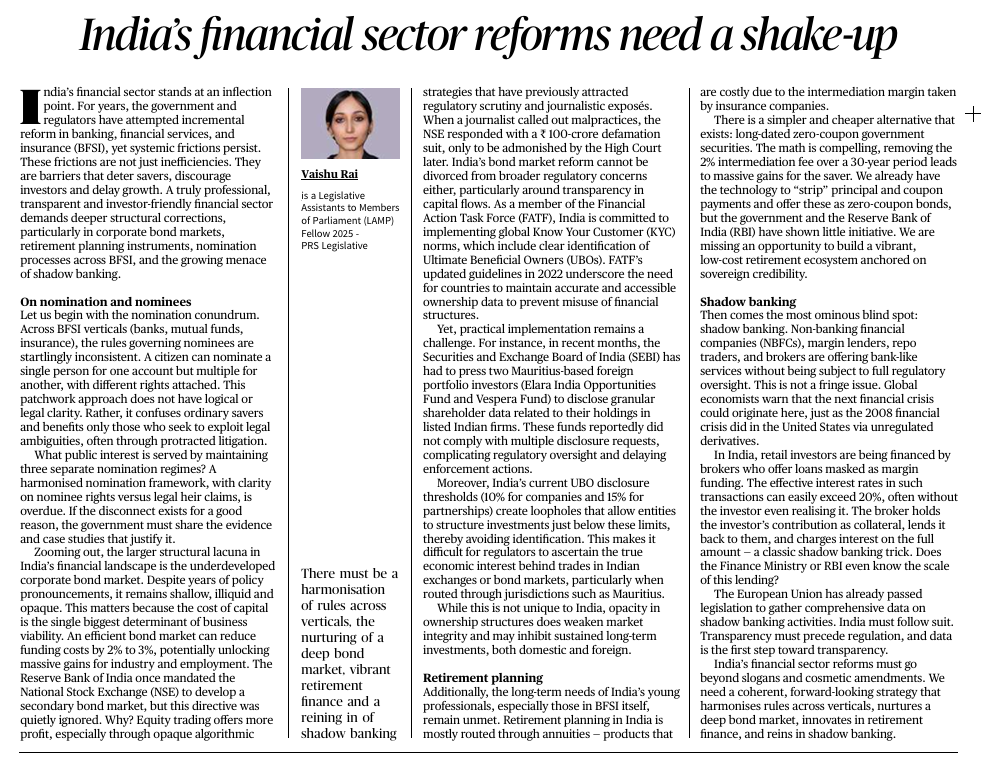1. Context and Thesis
- India’s financial sector is at an inflection point, with persistent frictions despite ongoing reforms in:
- Banking
- Financial services
- Insurance (BFSI)
- Banking
- These frictions discourage investment, delay growth, and deter savers.
- A truly transparent and investor-friendly financial system is urgently needed.
2. Problems in Nomination & Legal Framework
- Nomination rules across financial products (banks, mutual funds, insurance) are inconsistent and confusing.
- Citizens face issues such as:
- Naming multiple nominees with differing rules.
- Legal ambiguities that cause delays in claims.
- Exploitation by those misusing loopholes.
- Naming multiple nominees with differing rules.
- Need: Harmonised nomination rules and legal clarity across BFSI.
3. Corporate Bond Market Deficiency
- India’s corporate bond market is underdeveloped.
- Despite RBI’s mandate to develop a secondary bond market:
- Progress has been inadequate.
- High costs of capital remain a hurdle for business viability.
- Better bond markets can reduce funding costs by 2–3%, boosting jobs and investments.
- Progress has been inadequate.
- Issue: Regulatory opacity and fragmented policies deter growth.
4. Inadequate UBO (Ultimate Beneficial Owner) Disclosures
- Reforms on UBO transparency are weak:
- Mauritius-based funds not disclosing granular ownership details.
- SEBI’s updated UBO guidelines (10% shareholding or 15% in passive funds) still leave gaps.
- Need better identification of real beneficial owners, especially to prevent money laundering and tax evasion.
- Mauritius-based funds not disclosing granular ownership details.
5. Gaps in Retirement Planning Instruments
- India’s retirement ecosystem is complex, opaque, and intermediated:
- Private insurance and pension funds impose high charges.
- Zero-coupon government securities (long-dated) offer a cheaper, transparent
- Private insurance and pension funds impose high charges.
- Government and RBI have not utilized this potential despite technological feasibility.
- Missed opportunity to create a strong sovereign-backed pension framework.
6. Shadow Banking: The Biggest Threat
- Non-Banking Financial Companies (NBFCs), brokers, peer-to-peer lenders etc. offer bank-like services without stringent oversight.
- Investors unknowingly pay exorbitant interest rates (often 20%+).
- Brokers misuse investors’ funds as collateral and lend at high rates – classic shadow banking.
- Lack of data and oversight worsens the threat.
- Warning: Potential for financial crisis similar to 2008 (US mortgage crisis).
7. Lessons from Global Practices
- European Union is building regulations and data transparency in shadow banking.
- India needs:
- Forward-looking regulation
- Cross-vertical harmonisation
- Stronger enforcement of transparency and disclosure
- Forward-looking regulation
8. Conclusion: Call for Strategic Overhaul
- Cosmetic changes won’t suffice.
- A holistic roadmap is essential to:
- Harmonise rules across BFSI.
- Fix nomination processes.
- Develop bond markets.
- Build transparent retirement solutions.
- Harmonise rules across BFSI.
Address the shadow banking threat seriously.


